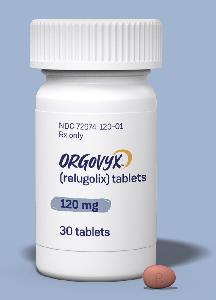Relugolix Disease Interactions
There are 2 disease interactions with relugolix.
Relugolix (applies to relugolix) osteoporosis
Major Potential Hazard, Moderate plausibility.
Relugolix is contraindicated for use in women with known osteoporosis because of the risk of further bone loss. Prior to initiating therapy, an assessment of bone mineral density by dual-energy X-ray absorptiometry (DXA) is recommended. Carefully consider the risks of treatment in women with a history of a low trauma fracture or risk factors for osteoporosis. Treatment should be limited to 24 months due to risk of continued bone loss which may not be reversible.
References
- (2023) "Product Information. Myfembree (estradiol/norethindrone/relugolix)." Myovant Sciences, Inc.
GNRH antagonists (applies to relugolix) QT prolongation
Moderate Potential Hazard, Moderate plausibility. Applicable conditions: Congestive Heart Failure, Electrolyte Abnormalities, Long QT Syndrome
Androgen deprivation therapy may prolong the QT/QTc interval. Health care providers should consider if benefits of therapy outweigh the potential risks in patients with congenital long QT syndrome, congestive heart failure, electrolyte abnormalities, or taking other drugs that can also prolong the QT interval. Consider periodic monitoring of EKG and electrolytes.
References
- (2013) "Product Information. Firmagon (degarelix)." Ferring Pharmaceuticals Inc
- (2021) "Product Information. Orgovyx (relugolix)." Myovant Sciences, Inc.
Relugolix drug interactions
There are 350 drug interactions with relugolix.
More about relugolix
- relugolix consumer information
- Check interactions
- Compare alternatives
- Reviews (18)
- Side effects
- Dosage information
- During pregnancy
- Drug class: gonadotropin-releasing hormone antagonists
- En español
Related treatment guides
Drug Interaction Classification
| Highly clinically significant. Avoid combinations; the risk of the interaction outweighs the benefit. | |
| Moderately clinically significant. Usually avoid combinations; use it only under special circumstances. | |
| Minimally clinically significant. Minimize risk; assess risk and consider an alternative drug, take steps to circumvent the interaction risk and/or institute a monitoring plan. | |
| No interaction information available. |
Further information
Always consult your healthcare provider to ensure the information displayed on this page applies to your personal circumstances.


